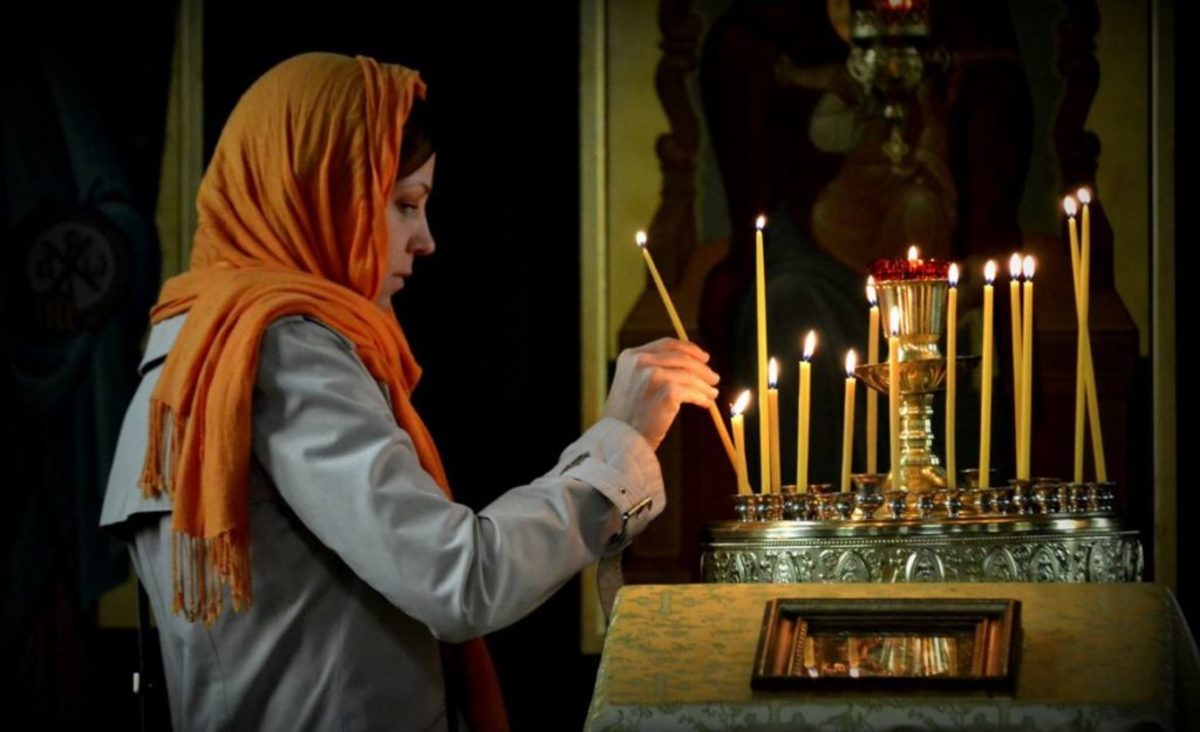Greco-Roman Religions: the Civic Cult (Religious Contexts of Early Christianity)
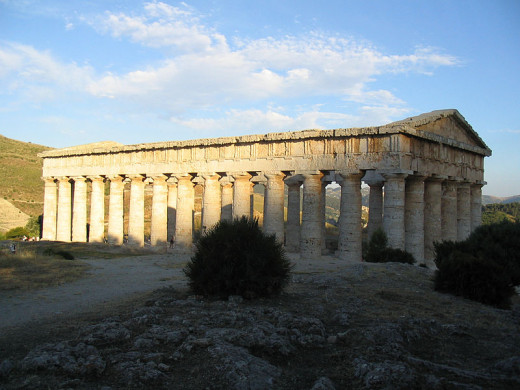
Civic Religion in Greco-Roman Culture
The public or civic religion of the Greeks and Romans is probably that aspect of their religiosity with which we are most familiar. Its public nature meant that it was widely known, uniform to some degree (at least within a city-state or larger geographical region), and practiced in the full view of public authorities. In the public worship of the Greeks and Romans, there was little that could be considered personal or private (unlike in domestic religion) or secret (as in the mystery cults).
Greco-Roman Religiosity
As mentioned in an earlier hub, the religions of the Greeks and Romans (at least those of the civic and domestic spheres) were religions with no revealed scripture, no real revealed dogma and therefore were not concerned with orthodoxy (that is, correct belief.)
They were not connected as such with a system of ethics or moral behavior (such as Shar'ia or the Ten Commandments), although certain gods were (broadly speaking) concerned with certain kinds of activity and behavior. For example, among the Greeks, Aphrodite was concerned with justice, Zeus with hospitality.
Greco-Roman religions tended to be ritualistic in character and concerned with orthopraxy (that is, correct practice of the rituals). In the civic cult at least, especially among the Romans, a misspoken word or a mistaken action could invalidate the offering and perhaps even make gods angry. That said, the purpose of Greco-Roman religion was NOT to rule citizens with fear, but allow them to establish a relationship with the gods based on a rational model - that of clients seeking a desired good from a patron - which was a social model well established in ancient Mediterranean culture.
While the religions were ritualistic and fairly traditional, they were highly syncretistic and adaptable to new situations and contexts and generally welcoming of new deities. (The official attitude of the Roman government was more ambivalent; we will discuss this in a future hub.)
Religious duties were imposed by a person's social status and their relationship to the household or state (being a family member brought certain ritual obligations, as did citizenship, marriage, etc.) That means, for instance, a foreigner in Rome, in theory, had no obligations to Roman deities. Unlike the mystery cults or Christianity, there was no formal initiation into the practice of this kind of religion. One's religion was determined by the network of relationships and affiliations; in domestic and civic religion, it was not a matter of personal choice (thus 'conversion' was meaningless). If someone's status changed - for instance, moving to a foreign land, joining the army, marrying into a different phratry (clan), gaining social rank, their "religions" changed as well (since it was defined so strongly by the social network).
The civic and domestic cults had no priestly caste (unlike the Brahmins in Hinduism), no centralized authority (such as the Pope or Patriarchs for Catholics and Orthodox Christians), no officially sanctioned, specially trained group to do exigesis (such as the Rabbis in Judaism), although philosophers and intellectuals did offer their own interpretations of rituals and texts.
In future hubs, when we turn our attention to the mystery cults - such as the ecstatic worship of Dionysius - we will see that not all of what was said applies. But in this hub, we have to turn our attention to the public or civic worship.
Public Worship
The discussion below will focus on three prominent forms of public worship - sacrificial offerings, votive gifts and a practice known as theoxeny which seems to have developed somewhat later in Roman history (according to a Roman historian who wrote at about the time of Jesus). These three are some of the most explicitly religious, but there are many other activities that have a religious dimension or component.
The ancient Greeks and Romans did not draw a clear line between religious and other cultural activities. They wouldn't make a "hard and fast" distinction between a religious event and a "non-religious" one the way most would in contemporary western culture. Most community events had a religious aspect, and religious events had a strongly communal dimension. Athletic competitions (such as the Olympic games or Roman games) had a strong religious dimension. Victory processions - when a Roman leader and his army returned in triumph to their hometown - also had a religious dimension, but we won't be talking about them here. Priests themselves were often considered employees of the city or state, as (at least in theory), the state could only exist through the continued patronage of its gods.
Just as a reminder, that many forms of religiosity and ritual activities that we associate with worship in the contemporary West would not be found there - such as preaching, devotional reading of religious scripture, communal hymns, charismatic or spontaneous prayer, witnessing to one's faith or evangelizing others.
Sacrificial Offerings
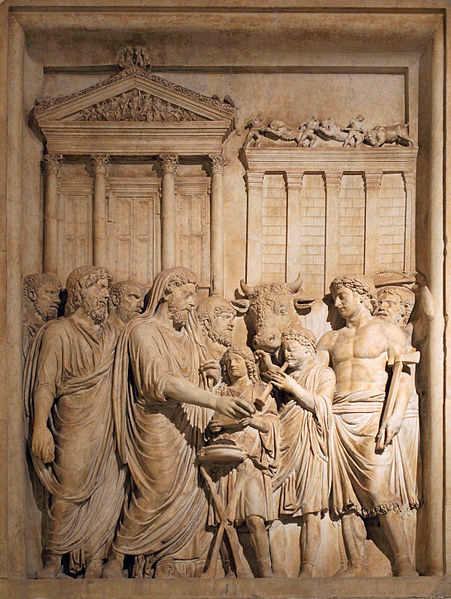
Sacrifices: Offerings to the Gods
The most common form of sacrifice for ancient Greeks and Romans was the slaughter of an animal followed by a sacrificial meal. Other things could be offered as well - certain kinds of vegetable matter (such as grains), liquids (in the form of libations) and incense. It was typically offered in a temple, but could be done elsewhere, usually in a temenos (τέμενος), an area set apart for a special purpose.
The sacrifice began with the selection of an appropriate animal. It was always something edible and domestic (that is, not hunted). The sacrifice of cattle was rare due to their cost; more often were pigs, goats, sheep and chickens offered. The animal had to be free from defects and blemishes and appropriate to the deity or deities being propitiated. (Certain gods preferred certain animals.)
The animal was lead in procession to the altar in front of the temple, adorned with ribbons and garlands. At the place of sacrifice, a fire would already have been set. The participants in the ritual ceremonially purify themselves and the animal (through a sprinkling of water or sometimes wine.) Apparently this action, when done to animals, caused them to jerk their heads, which the Romans considered an acknowledgement of consent on the animal's part. (The sacrificial victim was supposed to willingly give its consent to the sacrifice.)
If the animal was large, it would be stunned with a blow from a blunt object to its head, bringing it to its knees. Any sign of panic or unwillingness on the part of the sacrificial animal was a bad omen, thus they were often given drugged feed earlier in the day.
The throat of the animal was slit, allowing the blood to drain out. Afterwards, it was skinned and cut up. At least among the Greeks, the skin and bones of the animal, sprinkled with wine, were offered to the gods in the sacrificial fire. (From what I've read, this does not seem to be the case with Roman sacrifices though at least one source seems to imply that it was done by both cultures.)
A legend, recorded by the Greek poet Hesiod in Theogony, explains why only the bones and skin of animals were actually sacrificed to the gods:
For when the gods and mortal men had a dispute at Mecone, even then Prometheus was forward to cut up a great ox and set portions before them, trying to befool the mind of Zeus. Before the rest he set flesh and inner parts thick with fat upon the hide, covering them with an ox paunch; but for Zeus he put the white bones dressed up with cunning art and covered with shining fat. (Theogony, 542-43)
Thus the offering of skin and bones rather than the actual meat to the gods has its legendary origins in an attempted act of deception of a demi-god (Prometheus) upon a god (Zeus). The fooling of a supposedly wise and powerful god by a trickster figure is a common motif in Greek and other mythologies.
Throughout the offering prayers were made, making sure to remind gods to which of them the offering was directed, the person on behalf of whom the sacrifice was offered and what benefit they hoped to receive in exchange for the offering.
After an offering was made to the gods, the meat of the animal was cooked on spits or in pots and divided among the participants and celebrants (such as the priests). Sometimes, if the participants were especially generous, they would distribute some of the food to the public - freely offered meat was a rarity, but bread or some vegetable offerings might be given to the public by a wealthy benefactor.
Showing hospitality to the gods
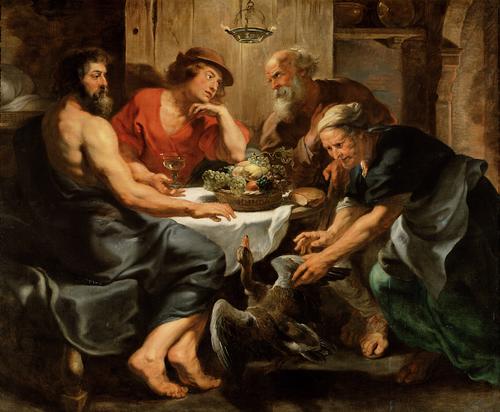
Theoxeny: Feasting the gods - the mythic foundations
Xenia (ξενία) was a central virtue to the ancient Greeks, it refers to the hospitality or friendship that one was supposed to offer to an xenos, a stranger or guest. Such a virtue was important in an age where there were seldom resting places for travelers and there was no law enforced between cities, leaving travelers at the mercy of bandits and ruffians. Zeus, central god of the Olympic pantheon, was the protector of travelers and wanderers. In this aspect, he was known as Zeus Xenios, "Zeus of the Guests". Zeus was thought to reward those who show hospitality and respect to their guests while punshing those who do them harm.
The theme seems to be common throughout the folklore of many cultures - gods or spiritual beings, often disguised as very old or impoverished people, visit a household in order to test their hospitality. One famous passage is from Homer's Odyssey, where the goddess Athena slips down from Mt. Olympus to visit the house of Odysseus:
...down she darted from the topmost summits of Olympus, whereon forthwith she was in the dêmos of Ithaca, at the gateway of Odysseus' house, disguised as a visitor, Mentes, chief of the Taphians, and she held a bronze spear in her hand... (Odyssey, Book 1:104-5)
The current guests of the house fail to even acknowledge her presence, as they are too caught up in their feasting and revelry. Instead, it is Telemachus, the eldest son of Odysseus, who sees the visitor and immediately offers him (Athena is disguised as a male chieftain) hospitality:
Telemakhos saw her long before any one else did...he caught sight of Athena and went straight to the gate, for he was vexed that a stranger should be kept waiting for admittance. He took her right hand in his own, and bade her give him her spear. "Welcome," said he, "to our house, and when you have partaken of food you shall tell us what you have come for."
He led the way as he spoke, and Athena followed him. When they were within he took her spear and set it in the spear - stand against a strong bearing-post along with the many other spears of his unhappy father, and he conducted her to a richly decorated seat under which he threw a cloth of damask. There was a footstool also for her feet, and he set another seat near her for himself, away from the suitors, that she might not be annoyed while eating by their noise and insolence...
A maid servant then brought them water in a beautiful golden ewer and poured it into a silver basin for them to wash their hands, and she drew a clean table beside them. An upper servant brought them bread, and offered them many good things of what there was in the house, the carver fetched them plates of all manner of meats and set cups of gold by their side, and a man-servant brought them wine and poured it out for them.
Telemachus, in being so generous to the stranger, has exemplified the Greek virtue of hospitality, while the other guests (and many others throughout the book) either ignore or actively harm the strangers. We find this in Biblical stories, such as in the books of Genesis, chapter eighteen, when three angels visit Abraham at Mamre and he offers them hospitality.
Theoxeny: Feasting the gods - the cultic practice
Theoxeny (from the Greek Θεοξένια, meaning "hospitality to the gods"), as a practice, refers to the ritual hospitality offered to the gods both publicly and privately, in temples and the open air on special feast days and other occasions. Images of gods were decorated and placed on couches and cushioned chairs and a table was placed in front of them, laden with food. (The ancient Romans practiced something similar, called lectisternium, meaning "spreading out a couch"). The images themselves could be pictures, statues, busts or something similar.
Not much is known about the details of the Greek practice, although the ancient Romans have left us an abundance of details about their practice of lectisternium. The Roman historian Livy (59 BC - 17 AD) claims that the first lectisternium was offered in 399 BC. According to his account, priests consulted Sibylline Books, records of oracular prophecies, in order to find a way to end a pestilence that threatened the city. According to the oracles, they were to set a feast for certain gods and hold celebrations for eight days.
By means of a solemn meal for the gods which was then to be held thoughout a period of eight days for the first time in the city, the college [of priests] of two members which was presponsible for the rites pacified Apollo and Platoni, Hercules and Diana, Merceury and Neptune on couches made ready with coverings and cushions, with all the splendor that could be achieved at that time. This ceremony was also carried out in private... (Urb. Condi. 5.1.3.6-8)
This became a common practice in Roman temples, with meals being offered regularly in honor of the gods, though special ones were offered in times of trouble, faminine, etc., to gain their favor.
What became of the food offered before the images of goddesses and gods? We don't know, but it seems likely that it was eaten by the human participants of the meals or the priests who arranged the service.
Votive Offerings

Votive Offerings
Public worship was not limited to sacrifices. Votive offerings (also called offerings ex voto, from the Latin term, "from a vow")were gifts given to the gods in fulfillment of a vow, usually made by a devotee who finds themselves in trouble. For example, someone gravely ill might promise an offering to a god of healing (such as Asclepius or Apollo) upon their return to health, a traveller caught at sea in a terrible storm might vow a gift to Poseidon or Neptune if he arrived home safely.
Some of the most famous are votive offerings that have been found in the remains of Asklepia, temple-hostel complexes dedicated to Asclepius, the Greek god of healing. The temples served as ancient rudimentary medical facilities where limited kinds of treatments and therapies were available. Many times however, the most effective remedy to an illness or debilitating condition would be delivered in a dream to the patient sleeping in the temple precints, a practice known as enkoimesis in Greek (ενκοίμησις; in Latin it is called incubatio), "incubation", or more literally, "sleeping in".
In their dreams, sometimes the patient would be visited by a god, such as Asclepius, who would heal them and in return ask them for a votive offering, sometimes an animal sacrifice (such as a chicken or pig), often times a clay or plaster model of the organ or limb healed, as can be seen in the picture above.
Such devotional offerings were not limited to Asclepius, but could be offered in gratitude any time that a person thought that a divinity had answered their prayer. Many temples had a special table, called the trapeza (τραπεζα) in the naos or the main hall, where worshippers could lay their votive offerings.
Sometimes even entire temples themselves could be a votive offering to a god. Ovid (43 BC-17 AD), in his poem Fasti (written c. 8 AD) remarks that a temple to Juno (the Roman equivalent of Hera) was the result of an ex voto offering by the Roman leader Marcus Furius Camillus (446-365 BC) for victory in battle:
The temple of Juno Moneta, dedicated on the Citadel's summit,/Vowed, Camillus, by you,/ Was once Manlius' house who drove the Gallic armies/Away from Jupiter Capitolinus. (Fasti, vi. 183-186)
In another reference to a votive offering, though the meaning is far from clear, is found in the last words of Socrates. In the dialogue Phaedo he is shown speaking to his disciple Crito:
Crito, I owe a cock to Asclepius; will you remember to pay the debt? (Phaedo, 118a)
What makes this so mysterious is the circumstances of this line: Socrates has just knowingly drank liquid made from hemlock, a lethal poison. He was condemned to death by the leading men of Athens for "corrupting" the youth of the city. Chickens were typically offered to Asclepius on the occasion of healing from a disease. Could this mean that Socrates himself (as Plato portrays him) viewed death as healing from the disease of living in a physical body? One could make an argument for this based on statements madeelsewhere in this dialogue and others, but we will never know for certain.
Augury and Omens
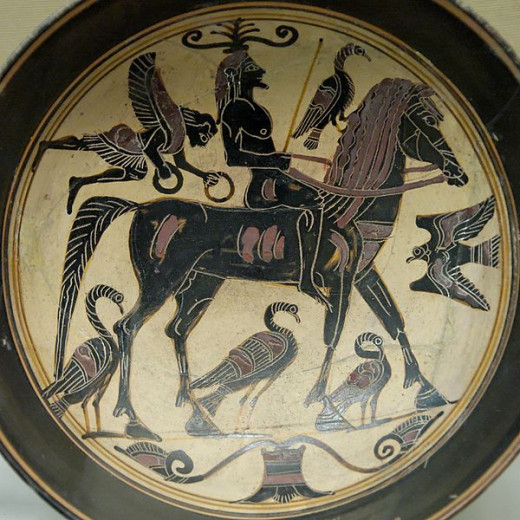
Signs, Omens and Portents
We have, so far, talked about how humans attempt to communicate, worship and appease deities in order to gain favors from them, a practice known in Latin as do ut des ("I give so that you give") or quid pro quo ("this for that"). We should say something briefly about another part of the "equation" of the human-divine relationship: ancient peoples of many cultures, from the Mayans (of Latin America) to the Yoruba (of western Africa) to the Chinese, Hindus, Babylonians and of course the Greeks and Romans believed that the gods could make their will known through signs or omens, in nature, in the stars and in what the Romans called prodigia (prodigies) violations of the natural order (such as the birth of a two-headed calf).
Augury was done in many contexts, both in domestic and civic or public frameworks. Many life events, such as marriage or the sealing of a business deal, would not be arranged without first consulting an augur and ascertaining the will of the gods. Indeed, major public or government actions would not be carried out without first consulting an appropriate augur. The Greek equivalent to the augur was θεοπρόπος,theopropos, the priest who interprets signs and omens, called σύμβολος, symbolos.
We know more about the Roman understanding of augury than we know of the Greeks. Romans divided it into two types - those deliberately sought (auspicia impetrativa) and those unsought (auspicia oblativa). Ones that were unsought, such as the prodigia noted above, usually were understood to be forewarn of something quite important as it was something carried out by the initiative of a god. Those deliberately sought were part of the routine functioning of daily life, both private and public.
The Romans in particular put an emphasis on watching the skies and the movement of birds. The English word auspicious derives from the Roman practice of watching birds fly through a window frame in the attempt to divine the future, a practice known as avis speculum ("bird watching"). Specially trained priests were selected for this, known as auspices.
Other priests, harauspices, were trained to read the entrails of slaughtered animals in order to ascertain omens. Though the Romans were especially known for this, Plato remarks that in Greek culture (where it was called hepatoscopy), it was considered more respectable than watching the flight patterns of birds.
If something dangerous or inauspicious was divined, priests could several things. First, they could consciously attempt to ignore (by avoiding sight of it) or re-interpret it as something good. This process was known as abominari, "averting an [ill] omen". The idea seems to be that the sign or portent has no significance unless it was observed and acknowledged by someone. If the omen could not be ignored or interpreted away, the priest to avert it through the offering of special sacrifices, called averruncare in Latin, thouhg these might not always be appropriate or effective. (If you look closely at that Latin word, you'll see the etymological root for the English word 'avert' there!)
Conclusion
In this hub, we've seen both how, in the context of public worship, mortals approached the gods in order to gain their favor as well as how the gods were thought to speak to humans (through signs and omens). One thing to take from this, though it may seem quite obvious, is that the gods were not silent partners in this relationship. These were not anonymous powers of nature that were worshipped, but anthropomorphic beings whom (while perhaps symbolizing or manifesting the powers of nature) were beings in their own right, with a will of their own, and choosing when and where to act in the world. Humans approached them as a client might approach a rich patron, to ask their favors and would offer something in return.
In the next hub on Greco-Roman religions, we will look at a phenomena of religious associations, where groups of people (sometimes called "sacrificial companions", orgeones, οργεωνεσ) would come together in order to hold feasts and honor gods in a semi-private setting, making it different both from the domestic cult (centered on the home and hearth) and the state or civic religion (centered on public worship in temples). It apparently began as a Greek phenomena that grew prominent after the slow collapse of the polis (city-state) in the wake of Alexander the Great's conquest towards the end of the fourth century BC. The Romans adopted it, though government officials were always wary of its foreign character.
Sources
Glossary of Ancient Roman Religion - http://en.wikipedia.org/wiki/Glossary_of_ancient_Roman_religion
Greek Religion Dictionary - http://greekreligiondictionary.blogspot.com/
Klauck, Hans-Josef. The Religious Context of Early Christainity. Brian McNeil, trans. (Minneapolis, MN: Fortress Press, 2003)
Rouse, William Henry Denham. “Greek Votive Offerings: An Essay in the History of Greek Religion”.(Cambridge: Cambridge University Press, 1902); full text can be found here:
http://www.archive.org/stream/greekvotiveoffer00rousuoft/greekvotiveoffer00rousuoft_djvu.txt
Scheid, John. An Introduction to Roman Religion. (Bloomington, Indiana: Indiana University Press, 2003)
Stell, David. “Sacrifices in Roman Religion”. http://www.romanarmy.net/sacrifices.htm



